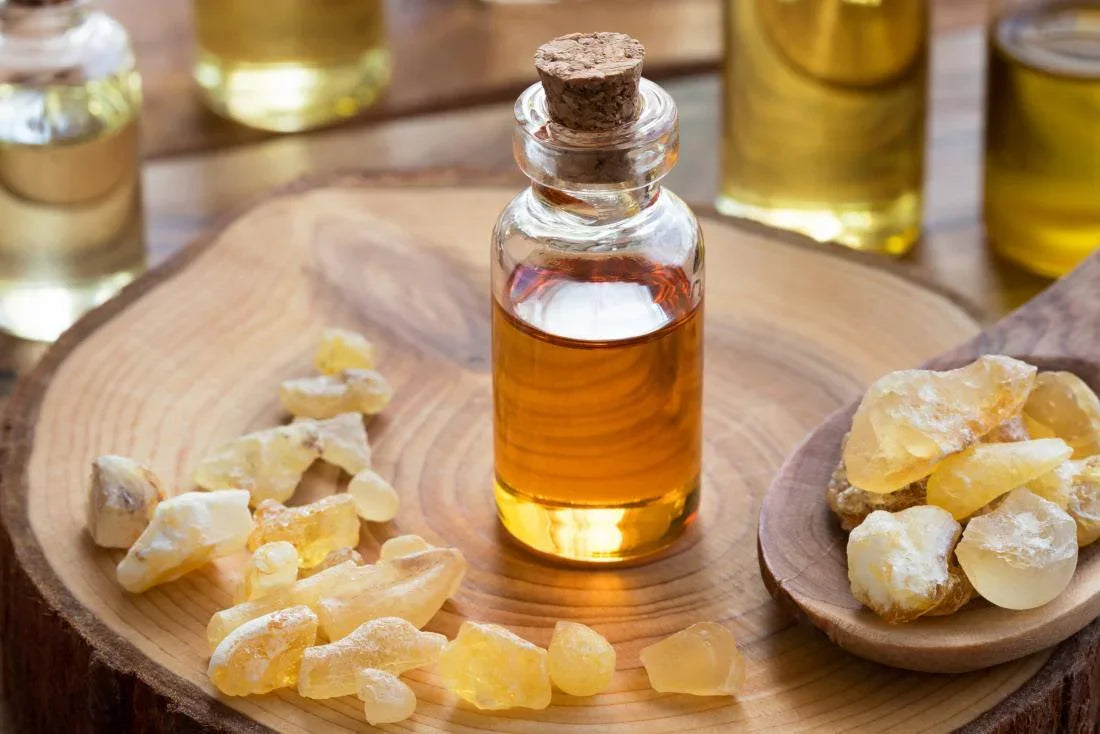Frankincense is a resin derived from the bark of trees that are indigenous to arid and semi-arid regions. We will go through the chemical compounds of frankincense, the best type of frankincense, frankincense water, frankincense oil, and frankincense smoke.
Boswellia Plant
Frankincense is a medicinal plant from the order Sapindales. The scientific names of this plant are Boswellia thurifera and Boswellia sacra.
Frankincense is a resin obtained from the bark of trees native to very hot regions of the Earth, typically found in dry and mountainous areas of India, Africa, and the Middle East. Initially, the resin exudes from the tree trunk in a liquid form, resembling milk, through incisions made in the bark. It then solidifies upon exposure to air. This transparent resin has properties that can be used to treat certain ailments and promote better health, although this aromatic resin has a bitter and astringent taste.
The Boswellia plant, in addition to its many uses, produces a resin that is utilized as a fragrance. Consequently, some people burn frankincense resin alongside wild rue seeds to scent the environment. The resin or gum exuded by frankincense has a unique aroma and a bitter taste. This resin is used in the cosmetic industry, in food products, and in scented soaps.
Chemical Compounds of Frankincense
The Boswellia plant contains a volatile oil (3-8%), gum (30-36%), acid resin (56-60%), and a resin known as "olibanum resin." The acidic resin includes triterpenoid acids such as beta-boswellic acid, acetyl-beta-boswellic acid, and keto-beta-boswellic acids, which are responsible for the therapeutic effects of frankincense.
The anti-inflammatory effects of frankincense primarily result from boswellic acids and terpenes, which are antioxidant compounds also found in citrus fruits, eucalyptus, and other plants. Studies suggest that boswellic acids reduce pain by inhibiting the synthesis of a specific pro-inflammatory enzyme.

Frankincense Side Effects
Despite the numerous therapeutic properties and benefits of frankincense, it is important to use it correctly and in appropriate amounts, as with any medicinal plant. Below are some of the potential side effects of excessive use of this substance.
1. Hyperactivity in Infants
A study conducted on 100 pregnant women found that prolonged use of frankincense (for 3 to 4 months) before delivery led to hyperactivity in their children. In contrast, women who used frankincense for a shorter duration (e.g., one month or less) did not experience such issues with their children; instead, these children often exhibited higher cognitive abilities. Generally, physicians recommend using frankincense to enhance a child's intelligence only from the fourth month of pregnancy and for no more than one month. Pregnant and breastfeeding women should avoid using high doses of frankincense for its therapeutic properties.
2. Development of Allergies
Individuals who have used frankincense daily sometimes experience issues such as acid reflux, nausea, and diarrhea due to sensitivity to the substance or excessive consumption. To prevent these problems, it is recommended to first ensure that frankincense is compatible with your body and to use it intermittently rather than continuously.
3. Drug Interactions
Frankincense may interact with certain medications. For example, it can affect drugs that are metabolized by the liver by slowing their breakdown. Additionally, using frankincense alongside these medications might increase their effects and side effects.
Examples of Medications That May Interact with Frankincense:
1. Antidepressants: Fluvoxamine, Imipramine, Paxil (paroxetine) and Zoloft (sertraline)
2. Blood Pressure and Arrhythmia Medications: Propranolol
3. Alzheimer’s Disease Medications: Tacrine
4. Painkillers and Sedatives: Diazepam
5. Anticoagulants: Warfarin
6. Pain Reducers: Diclofenac
7. Anti-Inflammatory Drugs: Ibuprofen, Aspirin
Recommendations:
Consult with your doctor before using frankincense if you are taking any of the above medications.
Topical application of frankincense may cause mild skin irritation in some individuals.
Patients with gastritis should use frankincense with caution.
4. Health Issues
Oral consumption of frankincense for up to 6 months is generally safe for adults. Similarly, topical use of frankincense for up to 5 weeks usually does not cause significant adverse effects, although it may cause allergic rashes in some individuals. However, like any substance, frankincense can cause side effects in some people, including stomach pain, nausea, vomiting, heartburn, skin itching, headaches, swelling, and general fatigue.
5. Exacerbation of Autoimmune Diseases
In individuals with autoimmune diseases such as multiple sclerosis, lupus, rheumatoid arthritis, and other related conditions, the use of frankincense may activate the immune system further. This activation can potentially worsen the symptoms of these diseases. Therefore, if you have an autoimmune condition, it is advisable to avoid using frankincense.
6. Temperamental Considerations
Due to its warming and drying properties, frankincense should be used with caution and in moderation by individuals with a warm temperament. Excessive use may lead to headaches and certain health issues, including some skin conditions. Overuse of frankincense can also cause the burning of blood and phlegm, and may result in nausea, abdominal pain, and loss of appetite.

Oral Consumption Methods of Frankincense
- Duration of Use: Frankincense is beneficial for memory, and the duration of its use depends on the individual's condition. Some may use it for extended periods, while others might only use it for one or two weeks.
- Preparation: Crush a teaspoon of frankincense and dissolve it in a small glass of water, then drink it every morning on an empty stomach.
- Chewing: Place a small pea-sized amount of frankincense in your mouth and chew it like gum for about twenty minutes, then discard the residue. The initial taste might be bitter and unfamiliar, but it will become more tolerable over time, especially after experiencing its health benefits.
- Infusion: Frankincense tea is another convenient way to consume it, making the process easier.
Best Type of Frankincense
Frankincense is available in various sizes and colors, but white frankincense is often considered superior to other types.
The best quality frankincense is fresh, free from impurities, and has a white color that does not crumble easily.
To test the purity of frankincense, you can burn a piece of it. Pure frankincense will ignite quickly and produce a scent similar to myrrh. When burning, frankincense with less smoke and more combustion indicates fewer impurities.
The visual similarity between frankincense and gum has led many to confuse the two, but they are distinctly different, each with its own unique characteristics.

How to Use Frankincense
Frankincense can be used in several forms: powder, chewing, inhalation, capsules, tablets, oil (for massage and topical creams), and smoke.
Powder Form: Mix a teaspoon of frankincense powder with honey. Due to its bitter and astringent taste, it can also be used in oil form for topical application or consumed in capsules. Frankincense oil can also be taken in capsule form.
Chewing: Chew a small piece of pure frankincense, about the size of a chickpea, for 10 to 15 minutes.
It can also be burned with Esfand seeds.
According to traditional medicine specialists, there are several methods for using frankincense:
1. Powder in Water: Grind the frankincense into a fine powder. Dissolve one teaspoon of the powder in a glass of water and consume it each morning on an empty stomach.
2. Chewing as Gum: Place frankincense in your mouth and chew it like gum. Although it may be somewhat bitter, chewing frankincense strengthens the gums, freshens breath, benefits memory.
3. Memory Improvement: For memory enhancement, frankincense can be consumed with honey. Soaking 3 grams of it in water daily for a few days and consuming it on an empty stomach in the morning is believed to help with memory loss and excessive phlegm.
Note: The use of frankincense is beneficial for up to two weeks when consulted with a traditional medicine specialist. Prolonged use may have adverse effects.
Frankincense Water
The benefits of frankincense extend to frankincense water as well. To prepare frankincense water, soak the frankincense in water overnight and consume it on an empty stomach the following morning. Alternatively, you can dissolve a portion of frankincense powder in a glass of water and drink it.
Frankincense Oil
To prepare frankincense oil, combine 5 parts sesame oil with 1 part ground frankincense in a glass jar.
Heat the mixture in a water bath on the stove for approximately one hour to ensure the frankincense is thoroughly infused into the oil. After heating, filter out any remaining frankincense particles and store the resulting oil in a dark, airtight container in a cool place. For a more concentrated oil, repeat this process two to three times.
Benefits of Frankincense Oil
- Muscle and Joint Pain Relief: Apply one or two drops of frankincense oil to the affected area before bedtime for relief, particularly effective for lower back pain.
- Skin Care: Acts as a moisturizer, helps reduce and eliminate scars, aids in skin repair and rejuvenation.
- Nail Care: Strengthens nails.
- Antiseptic Properties: Functions as a natural disinfectant.
- Warts and Insect Bites: Useful in treating warts and insect bites.
- Dandruff and Hair Health: Helps treat dandruff, reduces or prevents hair loss, and promotes healthy hair.
- Pain Relief: Provides general pain relief and can be used to soothe muscular pain.
- Stress Reduction: Apply to the temples or inhale to alleviate stress.
- Rheumatoid Arthritis: Offers natural treatment for rheumatoid arthritis.
- Gynecological Issues: Assists in addressing certain uterine problems.

Frankincense Smoke Benefits
- Antiseptic Qualities: When burned with Esfand seeds, frankincense smoke has disinfectant properties and helps purify the environment by killing microbes.
- Mood Enhancement: Frankincense smoke is uplifting and can dispel negative thoughts and anxieties.
- Cognitive Benefits: The smoke is believed to warm the brain and enhance memory by activating the brain’s therapeutic response (TRP).
- Nasal Bleed Prevention: Its smoke can help prevent nosebleeds.
- Hemorrhoid Relief: Burning frankincense may assist in treating hemorrhoid pain.
- Respiratory Health: It is effective in treating coughs, asthma, chest congestion, and other respiratory issues, and helps strengthen the lungs
- Sinus Health: Inhaling frankincense smoke helps clear nasal mucus and sinus infections.
- Negative Energy Removal: Burning frankincense and flixweed seeds together is believed to help dispel negative energies.
- Gynecological Health: Perform vaginal smoking by burning frankincense and Esfand seeds together. It is effective in treating uterine, bladder, and other female infections. It's recommended to continue this practice for a minimum of 10 and a maximum of 14 days.

External Sources
- 5 Benefits and Uses of Frankincense
- Anti-inflammatory and anti-cancer activities of frankincense
- The Effects of Frankincense Essential Oil on Stress in Rats
Have you tried using frankincense? If so, we would love to hear about your experience in the comments below!



